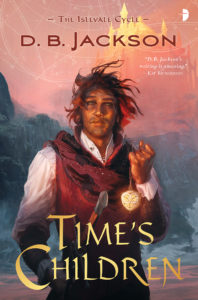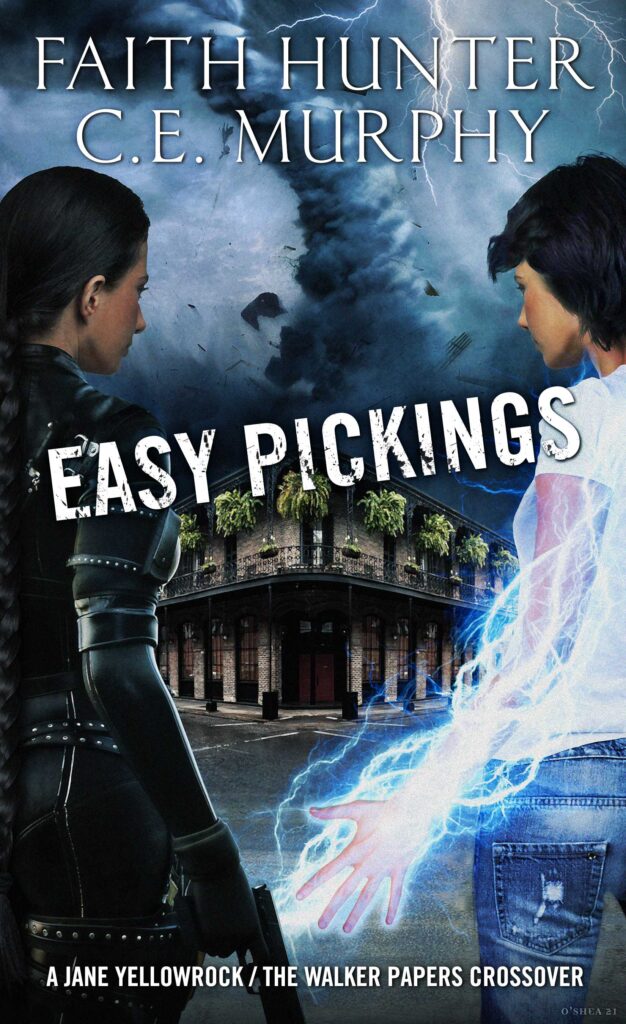My pal and sometime writing partner D.B. Jackson, who also writes as David B. Coe, is the award-winning author of twenty novels and as many short stories. His newest novel, Time’s Children, is the first volume in a time travel/epic fantasy series called The Islevale Cycle. IT IS FANTASTIC!!!!
The book will be released by Angry Robot Books tomorrow, October 2. He sat down to chat with me for a while about his new book and upcoming projects:
 ME: So. You know I LOVE this book. Tell my fans about TIME’S CHILDREN.
ME: So. You know I LOVE this book. Tell my fans about TIME’S CHILDREN.
TIME’S CHILDREN is the first book in a new time travel/epic fantasy series called The Islevale Cycle. I’m writing it under my pen name, D.B. Jackson, and it’s being published by Angry Robot Books. My protagonists, Tobias and Mara, are time travelers, or Walkers, as they’re known in Islevale. Tobias is sent back in time fourteen years to prevent a war. Shortly after he arrives in the past, however, the sovereign he serves is assassinated, his royal court decimated, and the royal family slaughtered. Except for his infant daughter, Sofya. It falls to Tobias to spirit her to safety, guard her from the assassins, and try to re-establish the royal line.
But, of course, the future has now been changed drastically by all that has happened. Mara still lives in that future, and is unaware of how different it is from the one she and Tobias knew together. In fact, she now has no knowledge of Tobias at all. She doesn’t remember him. But she is approached by Droë, a time demon, who does remember him. At Droë’s urging, Mara uses her powers to follow Tobias back in time, so that she can help him try to repair this dark misfuture. And from there, we’re off to the races.
ME: Dude. I write time stopping and time bubbling. It’s hard. Gimme the complicated details.
Well, it’s time travel, and, as other writers — not just you — had warned me, writing time travel will make one’s brain explode. But this is one of those odd cases in which a brief summary of the plot actually makes it seem more convoluted than it really is. As the world unfolds, and the magic system comes into relief, the narrative is pretty easy to follow.
That said, there are a few complicating factors that I’ve built into my time travel. First of all, not everyone can do it. It’s an ability that first manifests in childhood, and then must be honed through years of training. Second, Walkers need a device known as a chronofor in order to travel through time. A chronofor resembles a pocket watch, except it has three faces each with arms and a stem, that allow the Walker to set a destination time — bells (hours), days, and turns (months). Third, the chronofor is the only thing Walkers can carry when they travel back in time. They can carry no weapons, no money, and not even a stitch of clothing. Finally, and most importantly, for each day Walkers travel back in time (and forward again to their original moment in history) they age that amount. So I omitted a key detail from my summary: Tobias and Mara begin the book as fifteen-year-olds. They travel back in time fourteen years, and therefore arrive as 29-year-olds — at least to all outward appearances. Their emotions and intellects remain the same.
ME: What was the greatest challenge in writing this book?
I’m what’s known in writing circles as a planner. I tend to outline my novels. Not in tremendous detail, but with at least a brief paragraph for each chapter. This book, however, defied all my attempts to outline it. And I tried, I really did. For several months, I worked at jotting down at least some sense of the narrative path the story would follow. I just couldn’t do it. (And, for what it’s worth, I’ve had the same problem with TIME’S DEMON, the second book in the series, which I’m working on now.) I don’t know why I struggled so with the plotting. It may be that the complexities of time travel in a multi-strand, multi-point-of-view novel made that sort of advanced planning impossible. I wouldn’t have thought so, though, and the fact is those complexities would have been far easier to deal with had I been able to outline. Whatever the reason, plotting the book was a struggle. Now, in the end it all worked out. I think this is probably the best work I’ve done, and I believe the plotting is particularly strong. But it took a lot of work, and a massive edit/revision after the initial draft was complete to get there.
ME: You began your career writing epic fantasy [The LonTobyn Chronicle, Winds of the Forelands, Blood of the Southlands]. I met you back then. Dang that was a long time ago! Then moved away from epic fantasy for a time. What brought you back?
I suppose you could say that the same impulse that pulled me away from writing epic fantasy brought me back to it. As you say, I started out writing epic, and turned out three epic fantasy series – eleven novels in all. By the time I finished Blood of the Southlands, I was ready for something different. So I turned to urban fantasy – historical urban in my Thieftaker Chronicles (written as D.B. Jackson), contemporary urban in the Case Files of Justis Fearsson. These were very different books for me. They were essentially mysteries, detective novels really, with magical ingredients. They were leaner books. Generally speaking, each had one point of view character, and though they had subplots, these tended to feed directly into the central mystery. Put another way, all of the Thieftaker and Fearsson novels were very directed and streamlined. And I loved writing them.
But after seven urban fantasies, I was ready to return to my roots, as it were. I missed weaving together complex plotlines and telling my stories from the perspectives of several point of view characters. The Islevale books have allowed me to do that, and it’s been every bit as much fun as I remembered from those early books. Also, the Thieftaker and Fearsson series were set in the real world – Colonial Boston and modern-day Phoenix. I hadn’t built a new world in quite a while, and I missed that.
ME: It sounds like you’ve had fun with these books.
More than I can say. When I finished the two urban fantasy series that I had been working on, I asked my agent what she thought I should work on next. I had several ideas, and I thought it made sense to get input from her. She told me she wanted to see me work on a new epic fantasy, and she told me to “go wild.” She wanted me to stretch a bit, to take chances and do things I hadn’t tried before. The Islevale books are the product of that advice. I’ve pushed myself with this series – the complexity of my plots and my world, the intensity of what I’ve put my characters through, even the prose, which I have polished and honed as never before. As writers, we can always give ourselves new challenges, force ourselves to grow artistically. I’ve done that here, not just because my agent suggested that I do so, but because I want to. The choice is to stand still in a creative sense, and I don’t want to do that.
ME: What are you working on now?
I’m fortunate to be very busy these days, which is always good for a writer. I’m currently revising my first draft of TIME’S DEMON, the second Islevale novel, which will be released by Angry Robot Books in May 2019. It is a continuation of the story that begins in TIME’S CHILDREN, and I won’t say too much about it because I don’t want to spoil any surprises. I will tell you, though, that this book is every bit as complex and filled with twists and turns as book one. It’s also been every bit as challenging to write, which, in my experience, suggests that it will come out well.
Under my own name, I am working on a tie-in novel with a History Channel series called KNIGHTFALL, which tells the story of the end of the Order of the Knights Templar in early fourteenth century France. The book is called KNIGHTFALL: THE INFINITE DEEP, and it is actually a prequel to the series, set in 1291 in the immediate aftermath of the Siege of Acre. This marked the beginning of the end of the Crusades. That will be out from Titan Books in March 2019.
And I have other projects on my docket as well, including a possible editing gig, several pieces of short fiction, and a few novel ideas. As I say, busy is good.
ME: HUGS! Thank you for joining us today.
Thanks so much for having me!
*****
D.B. Jackson is the pen name of fantasy author David B. Coe. He is the award-winning author of twenty novels and as many short stories. His newest novel, Time’s Children, is the first volume in a time travel/epic fantasy series called The Islevale Cycle. The book will be released by Angry Robot Books on October 2. The second volume, Time’s Demon, will be released in May 2019.
As D.B. Jackson, he also writes the Thieftaker Chronicles, a historical urban fantasy set in pre-Revolutionary Boston. As David B. Coe, he is the author of the Crawford Award-winning LonTobyn Chronicle, which he has recently reissued, as well as the critically acclaimed Winds of the Forelands quintet and Blood of the Southlands trilogy. He wrote the novelization of Ridley Scott’s movie, Robin Hood, and, most recently, The Case Files of Justis Fearsson, a contemporary urban fantasy.
He is also currently working on a tie-in project with the History Channel. David has a Ph.D. in U.S. history from Stanford University. His books have been translated into a dozen languages.
 http://www.dbjackson-author.com
http://www.dbjackson-author.com
http://www.DavidBCoe.com
http://www.dbjackson-author.com/blog/
https://www.facebook.com/DBJacksonAuthor/
http://www.facebook.com/david.b.coe

